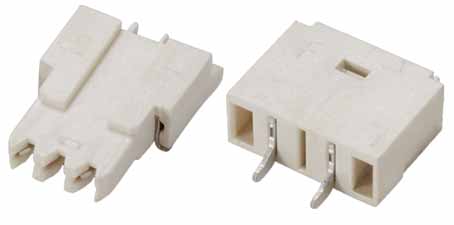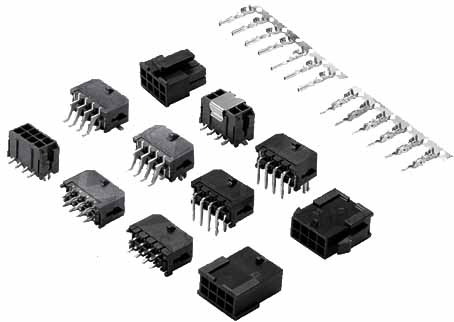Custom Wire-to-Board Connector Wiring Harness
There are many types of connectors, which can be divided into circular connectors, rectangular connectors, square connectors, customized connectors, etc. according to their shapes. According to the terminal connection form of the contact body: crimping, welding, winding, screw (cap) fixing; According to the connection mode, it can be divided into: board-to-board connector (B to B), wire-to-board connector (W to B), and wire-to-wire connector (W to W). According to the size, it can be divided into: 3.00mm (.118"), 3.50mm (.138"), 3.70mm (.148"), 3.96mm (.156"), 4.00mm (.157"), 4.14mm (. 163"), 4.20mm (.165"), 4.50mm (.177"), 5.00mm (.197"), 5.08mm (.200"), 5.70mm (.224"), 6.20mm (.244") ), 6.35mm (.250"), 7.92mm (.312"). Let's talk about the patch connector in the wire-to-board connector today.
Surface solder mount technology has been used by some manufacturers since the 1950s. However, the use of patch connectors has only recently begun, and has gradually been valued by manufacturers. This situation arises from the technical difficulties faced by the SMT connector and the failure to notice that the patch connector can effectively save the area of the board. It is found that the placement process can improve production efficiency and reduce costs for manufacturers and also reduce the board road area. Improve the design flexibility and other characteristics so that the patch connector is widely used.
Patch connectors are divided into: horizontal patch connector (SMT) and vertical patch connector (DIP). SMT generally mounts surface mount components without leads or short leads. The solder paste needs to be printed on the circuit board first, then mounted by a placement machine, and then fixed by reflow soldering. The DIP welding is a direct plug-in packaged device, and the device is fixed by wave soldering or manual soldering.
The overheating temperature of the patch connector is 3-5s above 260°. The composition of the patch connector: plastic parts and pin needles. The materials of plastic parts are generally PA6T and PA9T, both of which are resistant to high temperatures. Patch connectors are generally used in highway cameras, three-dimensional DC fans, smart electronics, air conditioners, high-definition LCD TVs, notebook computers and other fields. Among them, the material of Pin is generally brass, bronze, phosphor bronze, etc. The plating layer is generally gold-plated (semi-gold) or tin-plated. The function of the coating of the pin needle is to resist oxidation, improve the conductivity, and increase the transmission speed of the signal.
Surface solder mount technology has been used by some manufacturers since the 1950s. However, the use of patch connectors has only recently begun, and has gradually been valued by manufacturers. This situation arises from the technical difficulties faced by the SMT connector and the failure to notice that the patch connector can effectively save the area of the board. It is found that the placement process can improve production efficiency and reduce costs for manufacturers and also reduce the board road area. Improve the design flexibility and other characteristics so that the patch connector is widely used.
Patch connectors are divided into: horizontal patch connector (SMT) and vertical patch connector (DIP). SMT generally mounts surface mount components without leads or short leads. The solder paste needs to be printed on the circuit board first, then mounted by a placement machine, and then fixed by reflow soldering. The DIP welding is a direct plug-in packaged device, and the device is fixed by wave soldering or manual soldering.
The overheating temperature of the patch connector is 3-5s above 260°. The composition of the patch connector: plastic parts and pin needles. The materials of plastic parts are generally PA6T and PA9T, both of which are resistant to high temperatures. Patch connectors are generally used in highway cameras, three-dimensional DC fans, smart electronics, air conditioners, high-definition LCD TVs, notebook computers and other fields. Among them, the material of Pin is generally brass, bronze, phosphor bronze, etc. The plating layer is generally gold-plated (semi-gold) or tin-plated. The function of the coating of the pin needle is to resist oxidation, improve the conductivity, and increase the transmission speed of the signal.
| 3.00mm (.118") LED connector wire harness | |||
| product category | 3001 series | Rows | 1 |
| Product spacing | 3.00mm | Number of poles | 2 |
| product material | LCP, UL94V-0 | Rated current | 1A AC/DC |
| Product color | natural color | Rated voltage | 150V AC/DC |
| Cable size | (AWG) #26-28 | Contact resistance | 50mΩMax |
| Metal Material | phosphor bronze | Withstand voltage | 1000V AC/minute |
| plating | tin plating | temperature range | -25℃ - +85℃ |
| Wire diameter OD | 1.50mm(Max) | LED connector wire harness | |
| Product Image |
 |
||
| 3.00mm (.118") double row SMT connector | |||
| product category | 3025 series | Rows | 2 |
| Product spacing | 3.00mm | Number of poles | 2*2-2*12 |
| product material | PA66, UL94V-0 | Rated current | 5A AC/DC |
| Product color | natural color | Rated voltage | 250V AC/DC |
| Cable size | (AWG) #20-24 | Contact resistance | 10mΩMax |
| Metal Material | phosphor bronze | Withstand voltage | 1000V AC/minute |
| plating | tin plating/gold plating | temperature range | -25℃ - +85℃ |
| Wire diameter OD | 1.85mm (Max) | double row SMT connector | |
| Product Image |
 |
||





